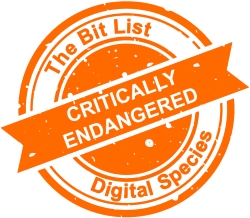Non-current Portable Solid State Media
 |
||
|
Materials saved to flash or other solid-state storage devices where the media is out of warranty and reader devices may no longer be supported or integrated easily into hardware infrastructure: typically, more than five years old. |
||
|
Digital Species: Portable Media |
Trend in 2023:
|
Consensus Decision |
|
Added to List: 2019 |
Trend in 2024:
|
Previously: Critically Endangered |
|
Imminence of Action Action is recommended within three years, detailed assessment within one year. |
Significance of Loss The loss of tools, data or services within this group would impact on people and sectors around the world. |
Effort to Preserve | Inevitability It would require a major effort to prevent or reduce losses in this group, possibly requiring the development of new preservation tools or techniques. |
|
Examples USB sticks and pen drives; Flash storage in cameras and phones; certain types of portable hard disk. |
||
|
‘Practically Extinct’ in the Presence of Aggravating Conditions Poor physical storage; inability to access readers; no replication; encryption; uncertainty over IPR or the presence of orphaned works. |
||
|
‘Endangered’ in the Presence of Good Practice Active management; dependable access to readers; strong documentation; documentation independent from the media. |
||
|
2023 Review This entry was added in 2019 to ensure that the range of media storage is properly assessed and presented. The 2019 Jury noted solid state media – typically flash – provides very fast access to data but can fail without warning. This is because it is typically subject to a limited number of program/erase cycles, as well as ‘read/disturb’ effects. Storage at scale also means the percentage likelihood of failure increases. The 2021 Jury and 2022 Taskforce agreed with the entry’s assigned risk classification with no noted changes towards increased or reduced risk. The 2023 Council agreed with the continued risk classification of Critically Endangered with the overall risks remaining on the same basis as before (‘No change’ to trend). They noted that many libraries, archives and other organizations are using these media as the access copy as well as the preservation copy. The data can be overwritten or lost by mishandling as well as bitrot and degradation. Data should be transferred into a digital preservation system that allows for active management. |
||
|
2024 Interim Review These risks remain on the same basis as before, with no significant trend towards even greater or reduced risk (‘No change’ to trend). |
||
|
Additional Comments An additional preservation risk here is that many libraries/archives use this media as the access copy as well as the preservation copy, thus increasing the risk of the data being overwritten, lost by mishandling as well as general bitrot and degradation. To decrease the risk, data should be transferred into a digital preservation system that allows for active management. Early generations of media and cheap giveaways are not robust and can deteriorate significantly over time. |
||









































































































































